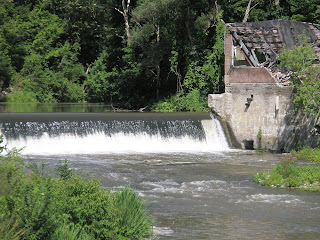For centuries after the arrival of Europeans in this corner of New York State, people produced their own food, clothing and shelter without the reliance on foreign imports characteristic of our time. The waterpower which now races unharnessed down our many streams once drove the machinery to produce textiles, lumber and grain. From the earliest times, the Dutch colonists used the power of falling water to grind grain and cut lumber, and produced their own clothing at home.
Inspired by the English factory system, the Americans began to manufacture clothing on a mass scale in the late 1700s, drawing on water power to run the machinery. By 1793, Samuel Slater's water-powered mill in Rhode Island was processing cotton from the slave states. The example soon spread to this region of cascading streams.
There are few places that better illustrate the old sustainable economy of waterpower, and its decline, than Stottville. The village takes its name from Jonathan Stott, a captured British soldier who chose to remain in the US after the War of 1812, and who has left many descendants. Inspired by his father's success as a manufacturer back in England, Jonathan started a weaving business in Hudson, NY. In 1828 he bought the hamlet then known as Springville from the wealthy landowners, the Van Rensselaers, in order to take advantage of the waterfalls in the Claverack Creek. Today all that remains of Stottville's 120 years of textile manufacture are the ruins of a large brick factory and the dramatic cascade over an adjacent dam.
Jonathan Stott’s mills specialized in the production of felt from wool and beginning in 1846, he replaced his earlier mills with what eventually became four large brick mills, all driven by the power of the creek. The Civil War was a prosperous time as the factories, under the direction of Jonathan’s sons, supplied Union army uniforms. The years after the war were also good for Stottville and the fourth five story brick factory was completed in 1876. Three dams furnished power for the textile machinery.
The Stotts were very much committed to state-of-the-art technology and from an early date maintained steam engines to run the machinery when drought or ice jam reduced the water flow. And Stottville was the site of the nation's first hydroelectric power generator . The turbine, a Morgan Smith, and waterwheel were installed in 1871.
The Panic of 1893 was the first blow to the long prosperity of the Stott enterprises and by 1901 both of Jonathan’s sons had died and the firm went bankrupt. However, textile manufacturing was still a lucrative business and Augustus Juilliard, a wealthy manufacturer who later endowed the Julliard School of Music in New York, bought the mills and his firm successfully ran them through World War I, the Depression, and World War II. In 1953 Juilliard went out of business, part of mass closings as the textile industry fled the Northeast in a pursuit of low wage workers that continues to this day.
For the next thirty years the four mills were mostly empty and falling into decay, despite a few efforts to use the buildings as the home for other smaller-scale industries. In 1978 the county demolished Mills 1 and 2, and in 1994 Mill 3 was destroyed by fire. Mill 4, stripped of much of its interior and its roof gone, still stands as a ruin beside the waterfalls.
Unlike depleted oil wells and ruined coal country, the water power of this region is as inexhaustible a resource today as it was four hundred years ago. It will be up to us to remember how to use it.
(For those interested in further reading, I recommend Hudson Valley Ruins: Forgotten Landmarks of an American Landscape by Thomas Rinaldi and Robert Yasinac)




Excellently written! My Dad’s famous ly worked in these mills from during WWII to their closing. His task was in the dyeing of the felt uniforms. Thank you for your research!
ReplyDeleteMy grandmother’s mother (my great grandmother) was a Stott. I have several pieces of china with the ‘S’ on them along with a beautiful 18th century secretary that came from the ‘big house’. My grandmother was a Pearson who’d married a Stott woman.
ReplyDeleteMy wife and I visited the village and were entertained by a lady who knew exactly how I was connected. There are still Stotts in the East living probably a day drive from Stottville, while I’m out here near Seattle.
My great grandmother was a Stott and married Jonathan Pearson. My grandmother married Col. Allen S. Peck and moved to Denver where he was a USForest Service chief forester. My mom inherited several l Stott family items which are now in my Seattle area home. A beautiful secretary and several pieces of china and silver with the ‘S’ on them. Wife and I visited about ten years ago and met a lady who know who my family was! Pete Vall-Spinosa
ReplyDeleteMy great grandmother was a Stott who married Jonathan Pearson. Daughter, Jessie married Allen peck who became the chief forester for Colorado. I live near Seattle and have a beautiful secretary and several pieces of china and silver with the ‘S’ on them. Visited the mill site several years ago and compared old pictures to what was there and met a woman who knew ware I fit into the family!.
ReplyDeleteBrian E Ridgeway
ReplyDeleteMy family immigrated from Manchester England to work & live in Stottville . My great grandfather Charles Ridgeway came first and married a Tanner who were weavers. They had grandpa Whilem Evans Ridgeway , lived In a company owned house and my father William E . Ridgeway was born in his mother’s bed. Grandpa was a janitor who job was to light the boilers in all the mills daily. My father worked in the mills through high school, went to New Paltz State teachers school , then proceeded to become an Episcopal Priest. He was the first Ridgeway to matriculate college .